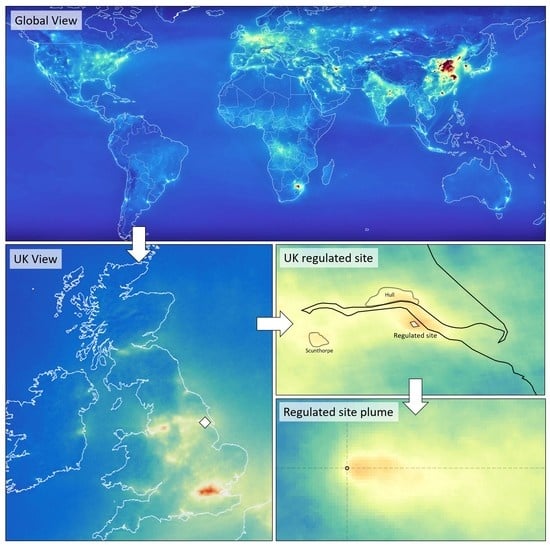Satellite Data Applications for Site-Specific Air Quality Regulation in the UK: Pilot Study and Prospects
Abstract
:1. Introduction
2. Regulatory Context
2.1. Air Quality Management in the UK
2.2. Environment Agency’s Role as a Regulator
3. Satellite Data for UK Regulation
3.1. Challenges in Utilising Satellite Data for UK Regulators
3.2. Moving towards Site-Specific Regulation
4. Case Study: Detecting Regulated UK Industrial Activity from Space
4.1. Oversampling for Temporal Averages
4.2. Temporal Average
4.3. Wind Speed and Wind Direction Aggregation
4.4. Wind Rotation Aggregation
5. Conclusions
Author Contributions
Funding
Data Availability Statement
Acknowledgments
Conflicts of Interest
Disclaimer
References
- World Health Organisation. Ambient Air Pollution: A Global Assessment of Exposure and Burden of Disease; World Health Organisation: Geneva, Switzerland, 2016.
- Cohen, A.J.; Brauer, M.; Burnett, R.; Anderson, H.R.; Frostad, J.; Estep, K.; Balakrishnan, K.; Brunekreef, B.; Dandona, L.; Dandona, R.; et al. Estimates and 25-year trends of the global burden of disease attributable to ambient air pollution: An analysis of data from the Global Burden of Diseases Study 2015. Lancet 2017, 389, 1907–1918. [Google Scholar] [CrossRef] [Green Version]
- Manisalidis, I.; Stavropoulou, E.; Stavropoulos, A.; Bezirtzoglou, E. Environmental and Health Impacts of Air Pollution: A Review. Front. Public Health 2020, 8, 14. [Google Scholar] [CrossRef] [Green Version]
- Landrigan, P.J.; Fuller, R.; Acosta, N.J.R.; Adeyi, O.; Arnold, R.; Basu, N.; Baldé, A.B.; Bertollini, R.; Bose-O’Reilly, S.; Boufford, J.I.; et al. The Lancet Commission on pollution and health. Lancet 2018, 391, 462–512. [Google Scholar] [CrossRef] [Green Version]
- Department for Environment Food and Rural Affairs. Air Pollution in the UK 2020. Available online: https://uk-air.defra.gov.uk/library/annualreport/viewonline?year=2020_issue_1 (accessed on 1 November 2021).
- Eskes, H.; van Geffen, J.; Boersma, F.; Eichmann, K.; Apituley, A.; Pedergnana, M.; Sneep, M.; Veefkind, J.; Loyola, D. Sentinel-5 Precursor/TROPOMI Level 2 Product User Manual Nitrogendioxide. 2019. Koninklijk Nederlands Meteorologisch Instituut (KNMI) CI-7570-PUM. Available online: https://sentinel.esa.int/documents/247904/2474726/Sentinel-5P-Level-2-Product-User-Manual-Nitrogen-Dioxide (accessed on 1 November 2021).
- Burrows, J.P.; Platt, U.; Borrell, P. The Remote Sensing of Tropospheric Composition from Space; Springer Science & Business Media: New York, NY, USA, 2011. [Google Scholar]
- Hakkarainen, J.; Szeląg, M.E.; Ialongo, I.; Retscher, C.; Oda, T.; Crisp, D. Analyzing nitrogen oxides to carbon dioxide emission ratios from space: A case study of Matimba Power Station in South Africa. Atmos. Environ. X 2021, 10, 100110. [Google Scholar] [CrossRef]
- Van Damme, M.; Clarisse, L.; Whitburn, S.; Hadji-Lazaro, J.; Hurtmans, D.; Clerbaux, C.; Coheur, P.F. Industrial and agricultural ammonia point sources exposed. Nature 2018, 564, 99. [Google Scholar] [CrossRef] [PubMed]
- Fioletov, V.E.; McLinden, C.A.; Krotkov, N.; Li, C. Lifetimes and emissions of SO2 from point sources estimated from OMI. Geophys. Res. Lett. 2015, 42, 1969–1976. [Google Scholar] [CrossRef]
- Fioletov, V.E.; McLinden, C.A.; Krotkov, N.; Li, C.; Joiner, J.; Theys, N.; Carn, S.; Moran, M.D. A global catalogue of large SO2 sources and emissions derived from the Ozone Monitoring Instrument. Atmos. Chem. Phys. 2016, 16, 11497–11519. [Google Scholar] [CrossRef] [Green Version]
- Beirle, S.; Borger, C.; Dorner, S.; Li, A.; Hu, Z.K.; Liu, F.; Wang, Y.; Wagner, T. Pinpointing nitrogen oxide emissions from space. Sci. Adv. 2019, 5, eaax9800. [Google Scholar] [CrossRef] [Green Version]
- Guerova, G.; Bey, I.; Attié, J.L.; Martin, R.V.; Cui, J.; Sprenger, M. Impact of transatlantic transport episodes on summertime ozone in Europe. Atmos. Chem. Phys. 2006, 6, 2057–2072. [Google Scholar] [CrossRef] [Green Version]
- Zhang, L.; Jacob, D.J.; Boersma, K.F.; Jaffe, D.A.; Olson, J.R.; Bowman, K.W.; Worden, J.R.; Thompson, A.M.; Avery, M.A.; Cohen, R.C.; et al. Transpacific transport of ozone pollution and the effect of recent Asian emission increases on air quality in North America: An integrated analysis using satellite, aircraft, ozonesonde, and surface observations. Atmos. Chem. Phys. 2008, 8, 6117–6136. [Google Scholar] [CrossRef] [Green Version]
- Onoda, M.; Young, O.R. Satellite Earth Observations and Their Impact on Society and Policy; Springer Nature: Basingstoke, UK, 2017. [Google Scholar]
- Stolarski, R.S.; Krueger, A.J.; Schoeberl, M.R.; McPeters, R.D.; Newman, P.A.; Alpert, J.C. Nimbus 7 satellite measurements of the springtime Antarctic ozone decrease. Nature 1986, 322, 808–811. [Google Scholar] [CrossRef]
- Abbasi, S.; Abbasi, T. The Ozone Hole. In Ozone Hole; Springer: Berlin/Heidelberg, Germany, 2017; pp. 13–35. [Google Scholar]
- Ricardo Energy and Environment. Investigating the Feasibility of Innovative Technologies to Improve Air Quality Monitoring over the Medium to Long Term. 2015. Available online: https://uk-air.defra.gov.uk/library/reports?report_id=909 (accessed on 1 November 2021).
- Highways England. Air Quality Strategy. 2017. Available online: www.gov.uk/government/publications/highways-england-air-quality-strategy (accessed on 1 November 2021).
- Minister for Environment and Land Reform. Cleaner Air for Scotland 2—Towards a Better Place for Everyone. 2021. Available online: www.gov.scot/publications/cleaner-air-scotland-2-towards-better-place-everyone (accessed on 1 November 2021).
- Brown, A.; Hayward, T.; Timmis, R.; Wade, K.; Pope, R.J.; Trent, T.; Boesch, H.; Barrio Guillo, R. Satellite Measurements of Air Quality and Greenhouse Gases: Application to Regulatory Activities; Environment Agency: Bristol, UK, 2021.
- Pope, R.J.; Kelly, R.; Marais, E.A.; Graham, A.M.; Wilson, C.; Harrison, J.J.; Moniz, S.J.A.; Ghalaieny, M.; Arnold, S.R.; Chipperfield, M.P. Exploiting satellite measurements to reduce uncertainties in UK bottom-up NOx emission estimates. Atmos. Chem. Phys. Discuss. 2021, 2021, 1–23. [Google Scholar] [CrossRef]
- Marais, E.; Pandey, A.K.; Van Damme, M.; Clarisse, L.; Coheur, P.-F.; Shephard, M.W.; Cady-Pereira, K.; Misselbrook, T.; Zhu, L.; Luo, G.; et al. UK ammonia emissions estimated with satellite observations and GEOS-Chem. J. Geophys. Res. Atmos. 2021, 18, e2021JD035237. [Google Scholar] [CrossRef]
- ClimateXchange. Using Satellite Data to Help Quantify Scottish Greenhouse Gas Emissions. 2020. Available online: https://www.climatexchange.org.uk/research/projects/using-satellite-data-to-help-quantify-scottish-greenhouse-gas-emissions (accessed on 1 November 2021).
- Vohra, K.; Marais, E.A.; Suckra, S.; Kramer, L.; Bloss, W.J.; Sahu, R.; Gaur, A.; Tripathi, S.N.; Van Damme, M.; Clarisse, L.; et al. Long-term trends in air quality in major cities in the UK and India: A view from space. Atmos. Chem. Phys. Discuss. 2021, 21, 6275–6296. [Google Scholar] [CrossRef]
- Potts, D.A.; Marais, E.A.; Boesch, H.; Pope, R.J.; Lee, J.; Drysdale, W.; Chipperfield, M.P.; Kerridge, B.; Siddans, R.; Moore, D.P.; et al. Diagnosing air quality changes in the UK during the COVID-19 lockdown using TROPOMI and GEOS-Chem. Environ. Res. Lett. 2021, 16, 054031. [Google Scholar] [CrossRef]
- Pope, R.J.; Marshall, A.M.; O’Kane, B.O. Observing UK Bonfire Night pollution from space: Analysis of atmospheric aerosol. Weather 2016, 71, 288–291. [Google Scholar] [CrossRef] [Green Version]
- Pope, R.J.; Graham, A.M.; Chipperfield, M.P.; Veefkind, J.P. High resolution satellite observations give new view of UK air quality. Weather 2019, 74, 316–320. [Google Scholar] [CrossRef] [Green Version]
- Pope, R.J.; Arnold, S.R.; Chipperfield, M.P.; Latter, B.G.; Siddans, R.; Kerridge, B.J. Widespread changes in UK air quality observed from space. Atmos. Sci. Lett. 2018, 19, e817. [Google Scholar] [CrossRef]
- UK Government Legislation. The Environmental Permitting (England and Wales) Regulations. 2016. Available online: https://www.legislation.gov.uk/uksi/2016/1154 (accessed on 1 November 2021).
- Department for Environment Food and Rural Affairs. Clean Air Strategy. 2019. Available online: https://www.gov.uk/government/publications/clean-air-strategy-2019 (accessed on 1 November 2021).
- European Parliment and the Council of the European Union. Industrial Emissions Directive. 2010. Available online: https://eur-lex.europa.eu/legal-content/EN/TXT/?uri=CELEX:32010L0075 (accessed on 1 November 2021).
- Rossby, C.-G. The Scientific Basis of Modern Meteorology; US Department of Agriculture, Climate and Man, Yearbook of Agriculture: Washington, DC, USA, 1941; pp. 599–655.
- Geddes, J.; Murphy, J.G.; O’brien, J.; Celarier, E. Biases in long-term NO2 averages inferred from satellite observations due to cloud selection criteria. Remote. Sens. Environ. 2012, 124, 210–216. [Google Scholar] [CrossRef] [Green Version]
- Cooper, M.J.; Martin, R.V.; McLinden, C.A.; Brook, J.R. Inferring ground-level nitrogen dioxide concentrations at fine spatial resolution applied to the TROPOMI satellite instrument. Environ. Res. Lett. 2020, 15, 104013. [Google Scholar] [CrossRef]
- Wu, S.; Huang, B.; Wang, J.; He, L.; Wang, Z.; Yan, Z.; Lao, X.; Zhang, F.; Liu, R.; Du, Z. Spatiotemporal mapping and assessment of daily ground NO2 concentrations in China using high-resolution TROPOMI retrievals. Environ. Pollut. 2021, 273, 116456. [Google Scholar] [CrossRef]
- Lamsal, L.N.; Martin, R.V.; van Donkelaar, A.; Steinbacher, M.; Celarier, E.A.; Bucsela, E.; Dunlea, E.J.; Pinto, J.P. Ground-level nitrogen dioxide concentrations inferred from the satellite-borne Ozone Monitoring Instrument. J. Geophys.Res. Atmos. 2008, 113, 113. [Google Scholar] [CrossRef] [Green Version]
- Pope, R.; Provod, M. Detection of the Yorkshire power stations from space: An air quality perspective. Weather 2016, 71, 40–43. [Google Scholar] [CrossRef] [Green Version]
- Beirle, S.; Boersma, K.F.; Platt, U.; Lawrence, M.G.; Wagner, T. Megacity Emissions and Lifetimes of Nitrogen Oxides Probed from Space. Science 2011, 333, 1737–1739. [Google Scholar] [CrossRef] [PubMed]
- Valin, L.C.; Russell, A.R.; Cohen, R.C. Variations of OH radical in an urban plume inferred from NO2 column measurements. Geophys. Res. Lett. 2013, 40, 1856–1860. [Google Scholar] [CrossRef]
- Pommier, M.; McLinden, C.A.; Deeter, M. Relative changes in CO emissions over megacities based on observations from space. Geophys. Res. Lett. 2013, 40, 3766–3771. [Google Scholar] [CrossRef] [Green Version]
- Dammers, E.; McLinden, C.A.; Griffin, D.; Shephard, M.W.; Van der Graaf, S.; Lutsch, E.; Schaap, M.; Gainairu-Matz, Y.; Fioletov, V.; Van Damme, M.; et al. NH3 emissions from large point sources derived from CrIS and IASI satellite observations. Atmos. Chem. Phys. 2019, 19, 12261–12293. [Google Scholar] [CrossRef] [Green Version]
- Clarisse, L.; Van Damme, M.; Clerbaux, C.; Coheur, P.F. Tracking down global NH3 point sources with wind-adjusted superresolution. Atmos. Meas. Tech. 2019, 12, 5457–5473. [Google Scholar] [CrossRef] [Green Version]
- Barkley, M.P.; González Abad, G.; Kurosu, T.P.; Spurr, R.; Torbatian, S.; Lerot, C. OMI air-quality monitoring over the Middle East. Atmos. Chem. Phys. 2017, 17, 4687–4709. [Google Scholar] [CrossRef] [Green Version]
- Spurr, R. Area-Weighting Tessellation for Nadir-Viewing Spectrometers; Internal Technical Note; Harvard-Smithsonian Centre for Astrophysics: Cambridge, MA, USA, 2003. [Google Scholar]
- Sun, K.; Zhu, L.; Cady-Pereira, K.; Miller, C.C.; Chance, K.; Clarisse, L.; Coheur, P.F.; Abad, G.G.; Huang, G.Y.; Liu, X.; et al. A physics-based approach to oversample multi-satellite, multispecies observations to a common grid. Atmos. Meas. Tech. 2018, 11, 6679–6701. [Google Scholar] [CrossRef] [Green Version]
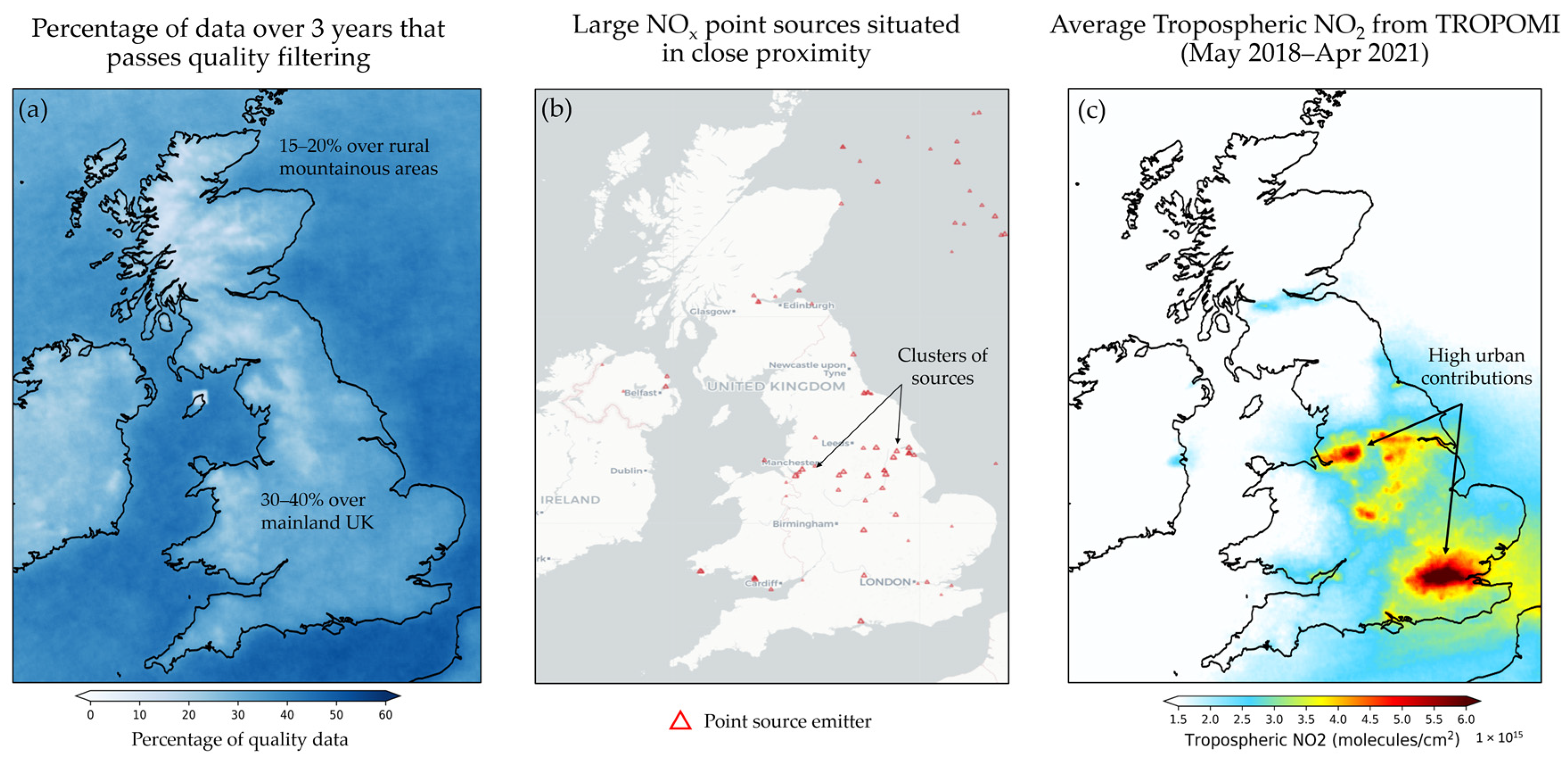
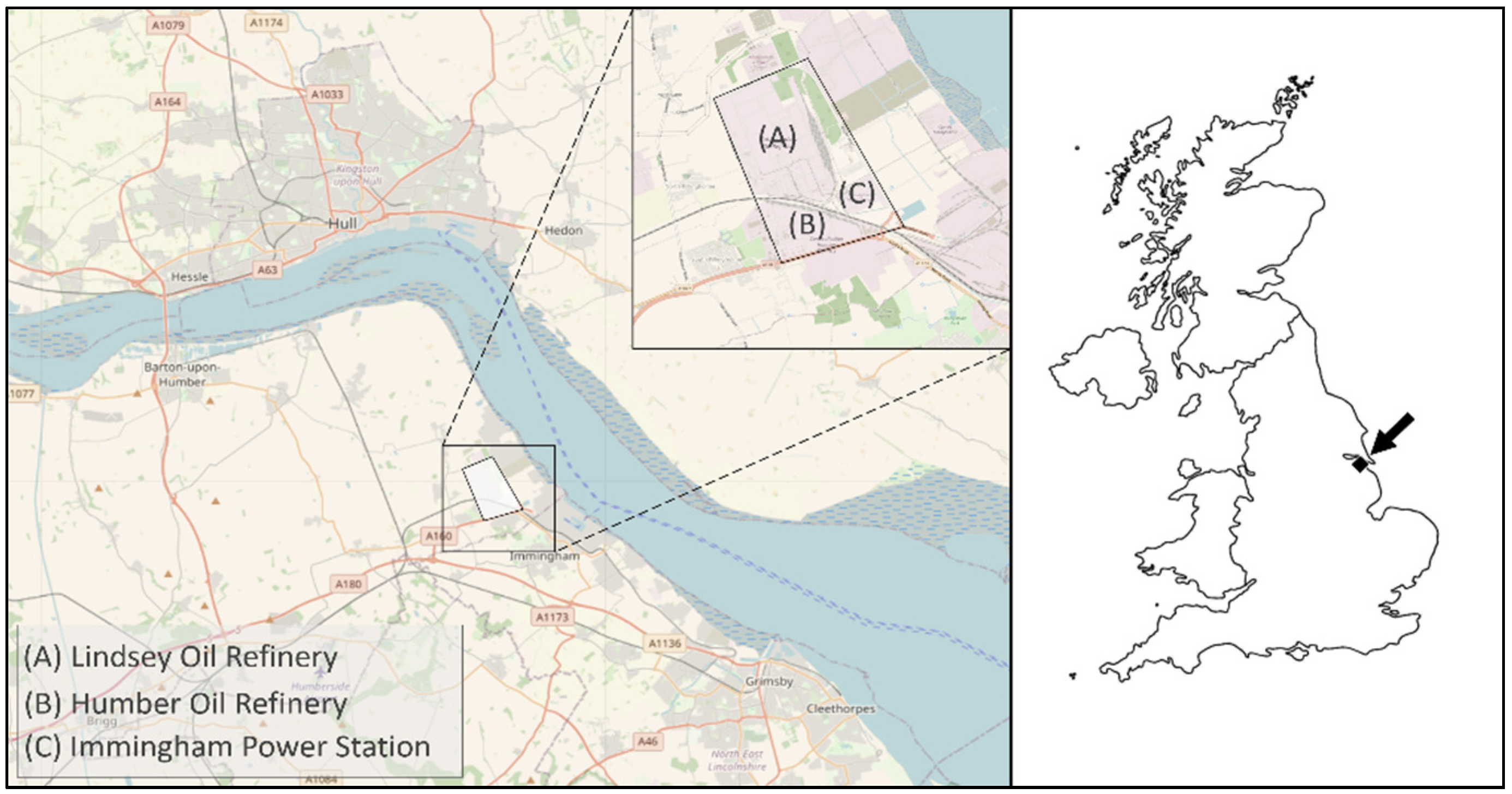
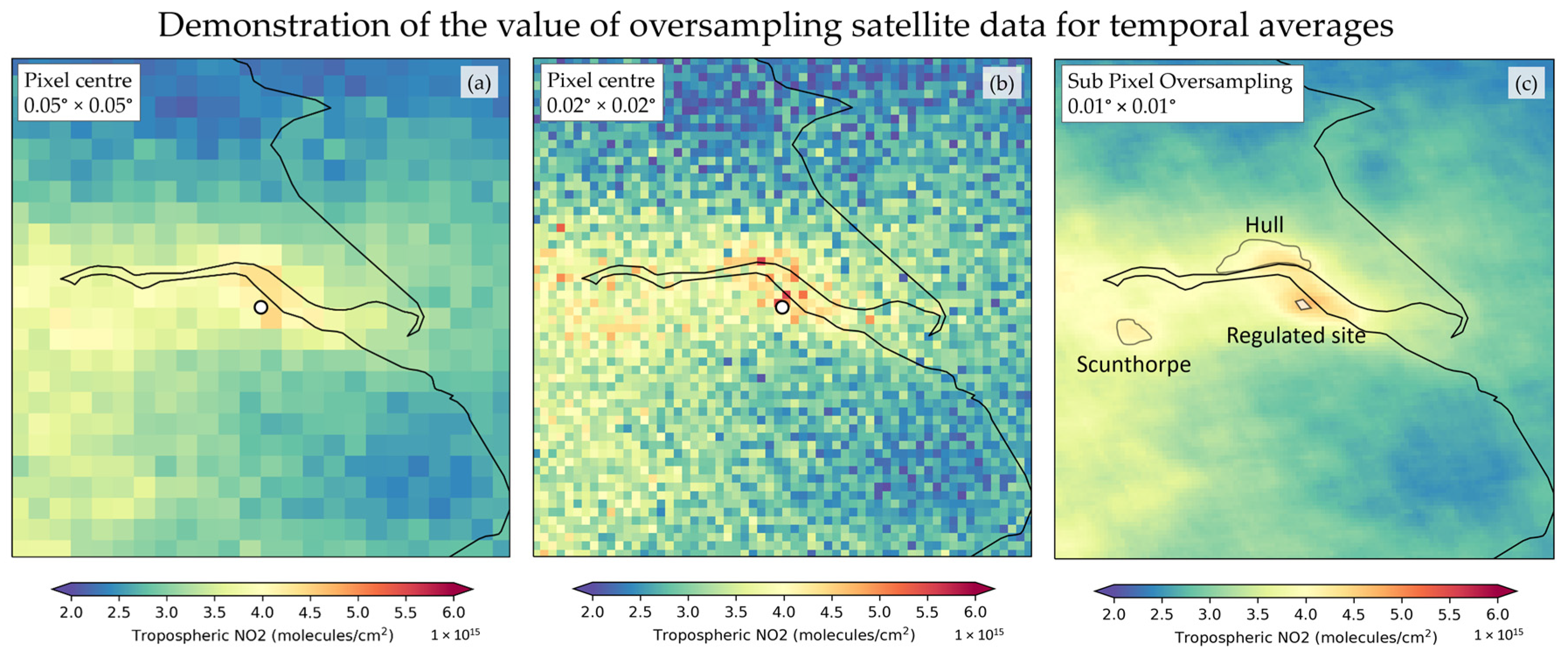
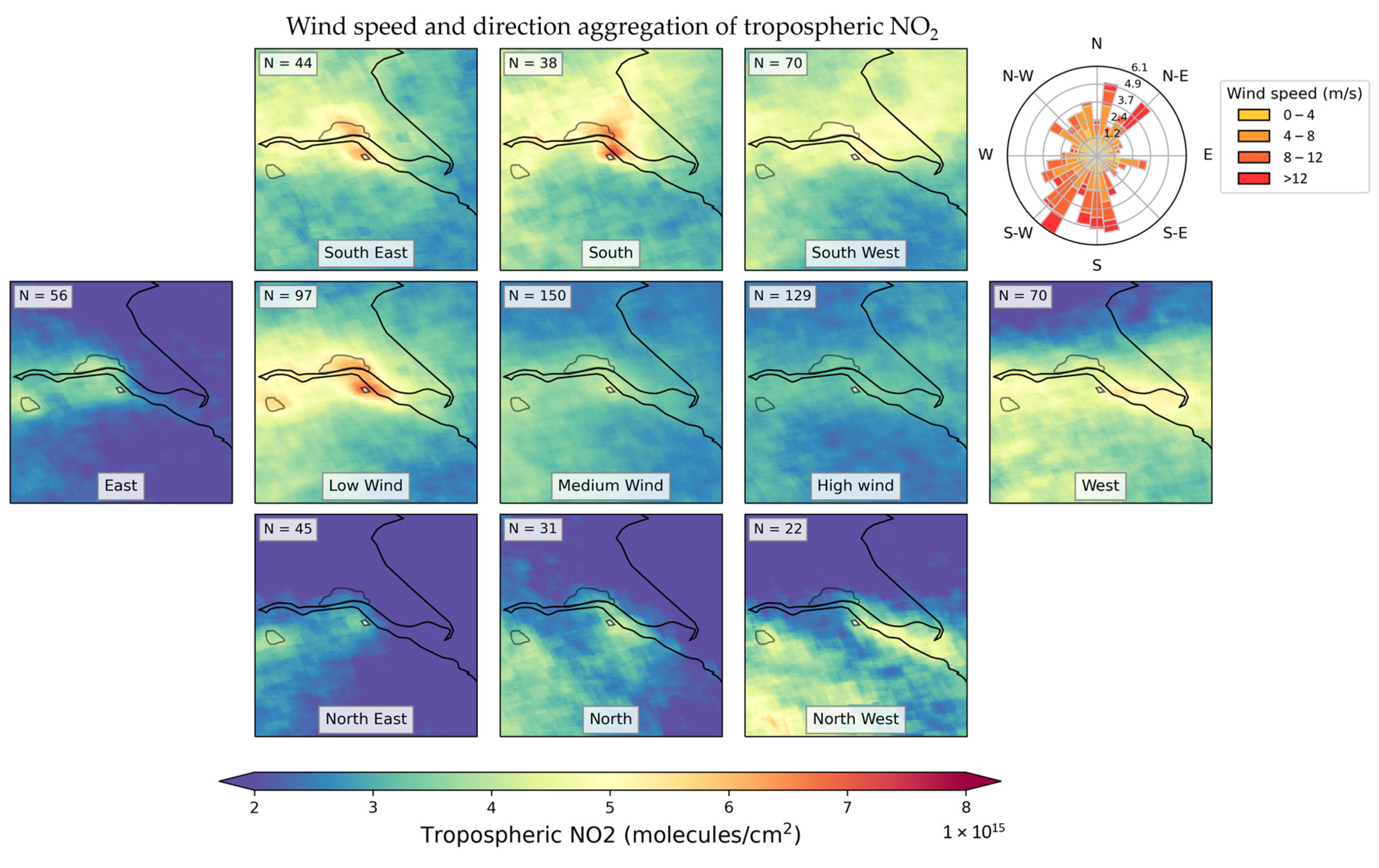
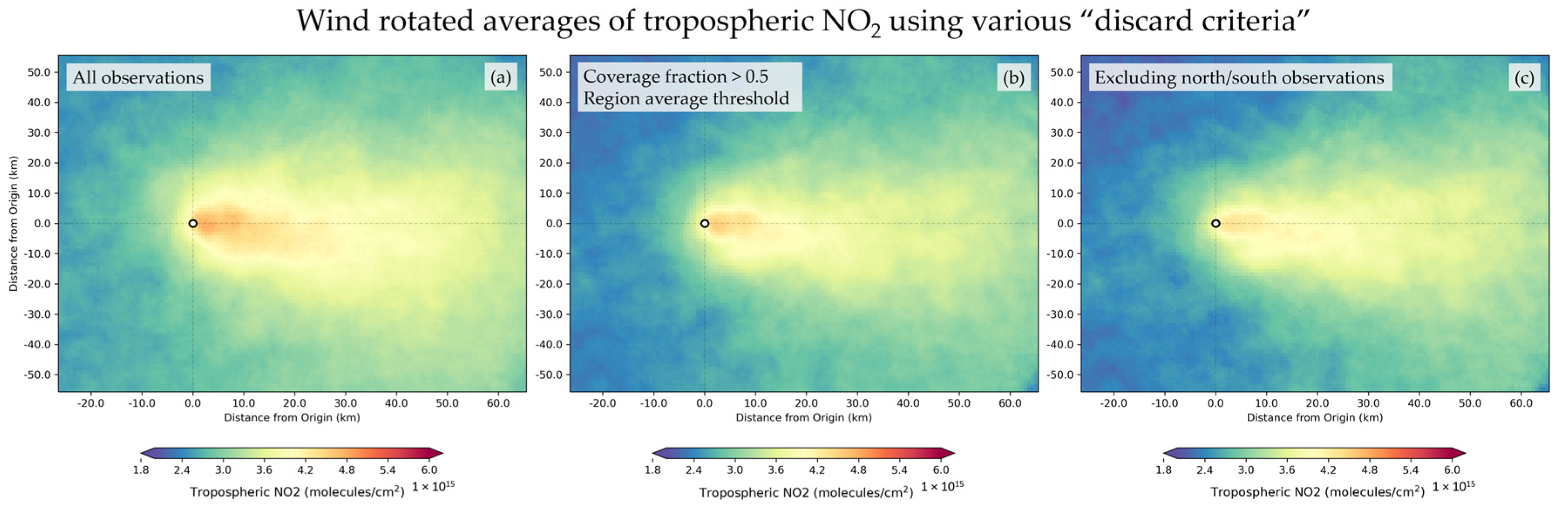
| Regulatory Field | Key Legislation |
|---|---|
| Regulation on the total emissions of air pollutants |
|
| Regulation on the concentrations of pollutants in ambient air |
|
| Regulation on the emission of pollutants from specific sources |
|
| Country | National Authority (Policy Maker) | Regulator/Policy Enforcement |
|---|---|---|
| England | Department for Environment, Food and Rural Affairs (Defra) | Environment Agency (EA) |
| Scotland | Scottish Government | Scottish Environment Protection Agency (SEPA) |
| Wales | Welsh Government | Natural Resources Wales (NRW) |
| Northern Ireland | Department of Agriculture, Environment and Rural Affairs Northern Ireland (DAERA) | Northern Ireland Environment Agency (NIEA) |
| Part A (1) Sources Regulated by the Environment Agency |
|---|
| Burning of fuel with a thermal input larger than 50 MW |
| Refining gas likely to involve the use of over 1000 tons of gas within 12 months |
| Incineration of hazardous waste |
| Disposal of waste into landfill greater than 10 tonnes per day |
| Rearing poultry or pigs intensively (40,000 poultry, 2000 pigs, 750 sows or more) |
| Reforming natural gas |
| Operation of coke ovens |
| Producing gas from oil |
| Refining mineral oils |
| Producing non-ferrous metals from ore, concretes, etc. |
| Various mining processes |
| Production of organic/inorganic chemicals |
Publisher’s Note: MDPI stays neutral with regard to jurisdictional claims in published maps and institutional affiliations. |
© 2021 by the authors. Licensee MDPI, Basel, Switzerland. This article is an open access article distributed under the terms and conditions of the Creative Commons Attribution (CC BY) license (https://creativecommons.org/licenses/by/4.0/).
Share and Cite
Potts, D.A.; Ferranti, E.J.S.; Timmis, R.; Brown, A.S.; Vande Hey, J.D. Satellite Data Applications for Site-Specific Air Quality Regulation in the UK: Pilot Study and Prospects. Atmosphere 2021, 12, 1659. https://doi.org/10.3390/atmos12121659
Potts DA, Ferranti EJS, Timmis R, Brown AS, Vande Hey JD. Satellite Data Applications for Site-Specific Air Quality Regulation in the UK: Pilot Study and Prospects. Atmosphere. 2021; 12(12):1659. https://doi.org/10.3390/atmos12121659
Chicago/Turabian StylePotts, Daniel A., Emma J. S. Ferranti, Roger Timmis, Andrew S. Brown, and Joshua D. Vande Hey. 2021. "Satellite Data Applications for Site-Specific Air Quality Regulation in the UK: Pilot Study and Prospects" Atmosphere 12, no. 12: 1659. https://doi.org/10.3390/atmos12121659
APA StylePotts, D. A., Ferranti, E. J. S., Timmis, R., Brown, A. S., & Vande Hey, J. D. (2021). Satellite Data Applications for Site-Specific Air Quality Regulation in the UK: Pilot Study and Prospects. Atmosphere, 12(12), 1659. https://doi.org/10.3390/atmos12121659





